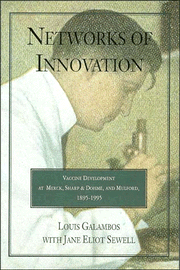Book contents
- Frontmatter
- Contents
- PREFACE
- 1 1894: “The foremost medical question of the day”
- 2 The Mulford Story
- 3 A Sharp & Dohme Interlude
- 4 The Virology Network and a New Program at Merck Sharp & Dohme
- 5 Hilleman's Innovations: First Phase
- 6 Dangerous Interlude
- 7 Transforming Bacteriology: A Second Phase
- 8 New Networks, New Leadership: The Hepatitis B Vaccines
- 9 Vaccine Innovation in the Nineties: New Strategies, New Opportunities, and Public Confrontations
- 10 Historical Perspectives on the Process of Innovation
- ACKNOWLEDGMENTS
- A WORD ABOUT SOURCES
- INDEX
- Plate section
4 - The Virology Network and a New Program at Merck Sharp & Dohme
Published online by Cambridge University Press: 06 July 2010
- Frontmatter
- Contents
- PREFACE
- 1 1894: “The foremost medical question of the day”
- 2 The Mulford Story
- 3 A Sharp & Dohme Interlude
- 4 The Virology Network and a New Program at Merck Sharp & Dohme
- 5 Hilleman's Innovations: First Phase
- 6 Dangerous Interlude
- 7 Transforming Bacteriology: A Second Phase
- 8 New Networks, New Leadership: The Hepatitis B Vaccines
- 9 Vaccine Innovation in the Nineties: New Strategies, New Opportunities, and Public Confrontations
- 10 Historical Perspectives on the Process of Innovation
- ACKNOWLEDGMENTS
- A WORD ABOUT SOURCES
- INDEX
- Plate section
Summary
FOR THE biologicals and pharmaceutical industries of the United States, the decades following World War II were filled with unusual opportunities. In the domestic economy, these were years of prosperity and growth, labeled “The American Century” by Life magazine's Henry Luce. As that slogan correctly predicted, the United States emerged from the war as the world's dominant economic power, and the nation's multinational corporations were now able to penetrate foreign markets that had long been controlled by European and Asian competitors. Economies of scale and scope were important sources of competitive advantage. But the growth of U.S. companies was also propelled by the innovations stemming from their fruitful interaction with America's complex array of professions, including those in science and engineering.
Science-based industries benefited from the burgeoning of a new government/university complex that pumped billions of public dollars into professional training and research. Many of the federal programs were justified by reference to national security and all were buttressed by the widespread confidence that the nation's success in World War II had to a considerable degree been a product of its scientific and technological prowess. In this favorable economic and political setting, complex innovative networks developed in electronic computing, atomic power, microwave transmission, liquid gases, medicinal chemistry, biochemistry, and virology – to mention only a few. In the fields related to medical science, the national security theme was sotto voce, and this facilitated the exchange of ideas nationally and internationally. As we have seen, cooperative exchanges of this sort had been extremely fruitful for America and for its medical sciences during the earlier cycle of innovation in which the H. K. Mulford Company had been an active participant.
- Type
- Chapter
- Information
- Networks of InnovationVaccine Development at Merck, Sharp and Dohme, and Mulford, 1895–1995, pp. 53 - 78Publisher: Cambridge University PressPrint publication year: 1996



